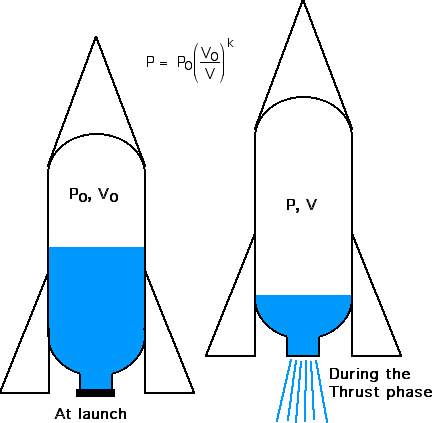Water Rocket Analysis (Page 2)
We continue with the Water Rocket analysis
with a summary of the four equations developed so far on Page 1. Note that all of this analysis
is relevant to the upwards thrust phase of the rocket flight,
while the water is being expelled through the nozzle by the compressed
air.
The basic rocket Force equation:

The thrust force in terms of the water expelled
through the nozzle:

Bernoulli's equation, relating the pressure
applied by the compressd air to the velocity of the exhausting
water:

Note that the resulting thrust force is twice
the pressure difference times the nozzle area:

Unfortunately the compressed air pressure P
is not a constant during the thrust phase, but varies in a nonlinear
manner with the expanding volume of the compressed air. This is
the main reason for the extremely complex relations resulting
from this analysis.
As the water escapes, the air volume increases,
causing a decrease in pressure and a corresponding decrease in
thrust. We consider this process to be adiabatic (no transfer
of heat during the split-second expansion process), which allows
us to relate the time variation of the pressure to that of the
volume.

The adiabatic expansion process is derived
from the energy equation applied to an ideal gas, and is developed
in the section on Adiabatic Expansion
Analysis leading to the following equation:

where:
P0
is the initial absolute pressure at liftoff [Pa]
V0
is the initial volume of the compressed air [m3]
k
is the ratio of specific heat capacities [k = 1.4 for air]
P, V are the respective
time varying pressure and volume of the compressed air during
the thrust phase.
Compressed Air Volume Variation
The volume variation of the compressed air
due to the water escaping through the nozzle is given by:

Substituting equations 3 and 5 into equation
6 and simplifying, we obtain:

Equation 7 is the differential equation for
the volume variation of the compressed air as a function of time
t. It cannot be solved explicity since the volume V is deeply
embedded in a nonlinear manner in the equation, hence we resort
to a numerical solution. It is of extreme importance to solve
it however, since only through the solution of equation 7 can
we know when all the water has been expelled denoting the end
of the thrust phase, leading to the determination of the Duration
of Thrust.
The numerical
solution of ordinary differential equations (ODEs) is
an important generic problem in engineering, and you will no doubt
learn various methods of solving them (such as the Runge-Kutta
methods). The main reason for introducing this analysis here was
to indicate the importance of the adiabatic process analysis in
the study of water rockets.
For those of you who wish to continue with
this analysis through to the development of the acceleration,
velocity and height differential equations we continue with the
final page of the water rocket analysis.

______________________________________________________________________________________

Engineering Thermodynamics by Israel Urieli is licensed under a
Creative Commons Attribution-Noncommercial-Share
Alike 3.0 United States License
![]()
![]()
![]()
![]()



